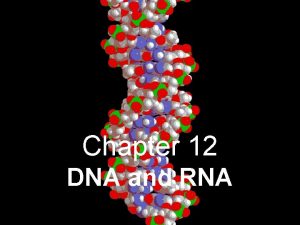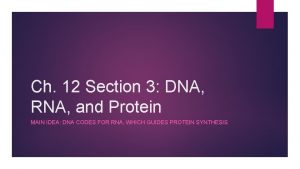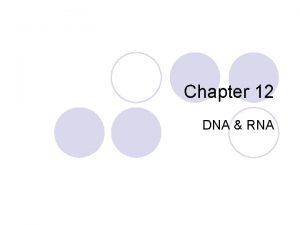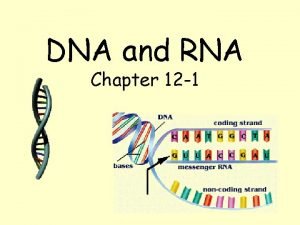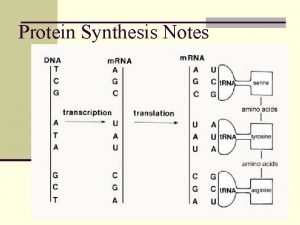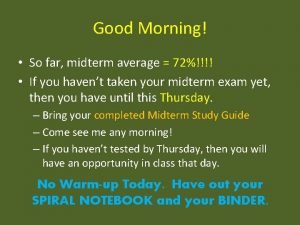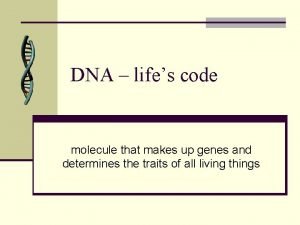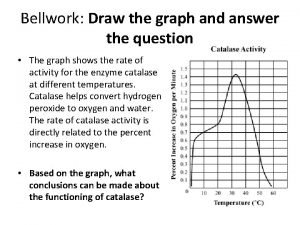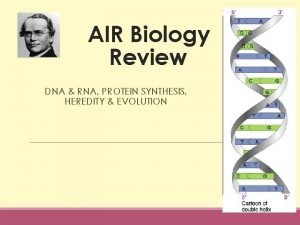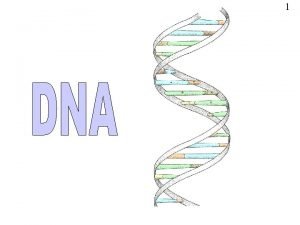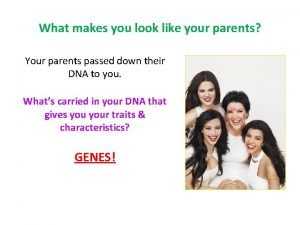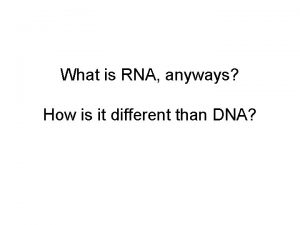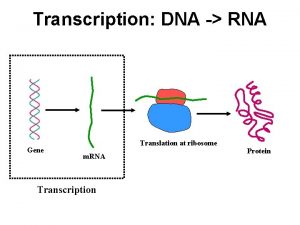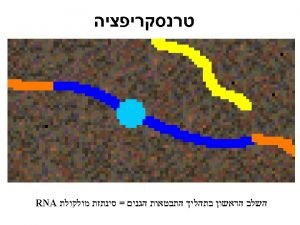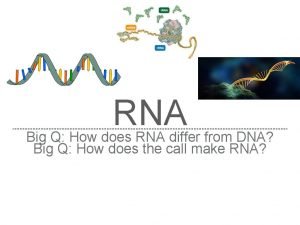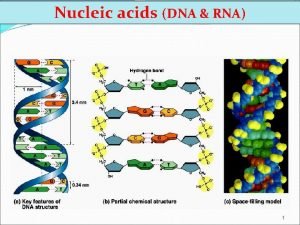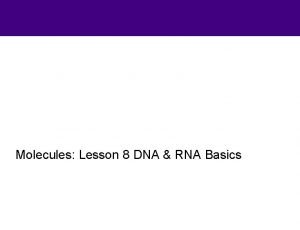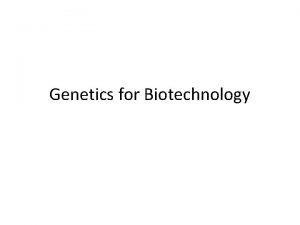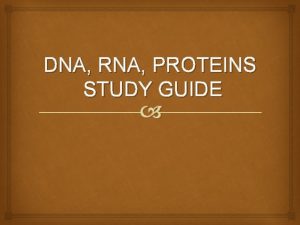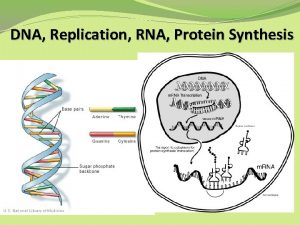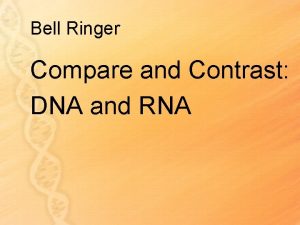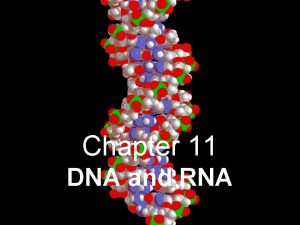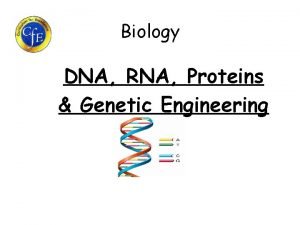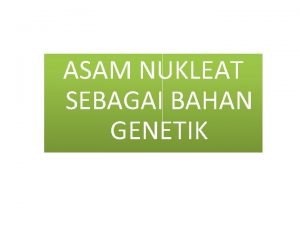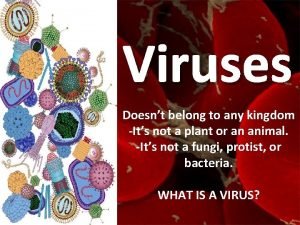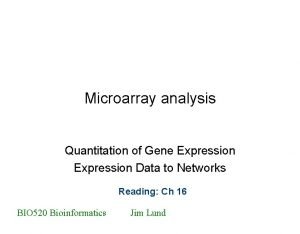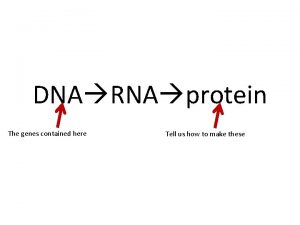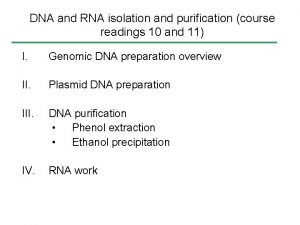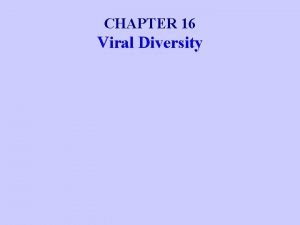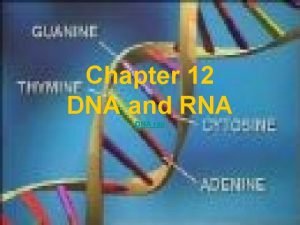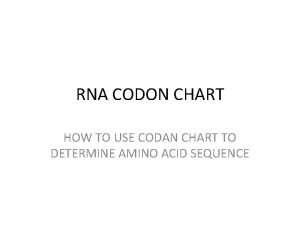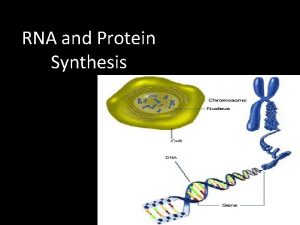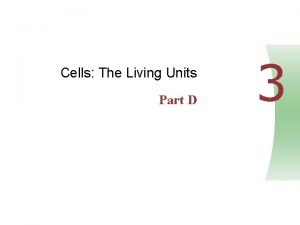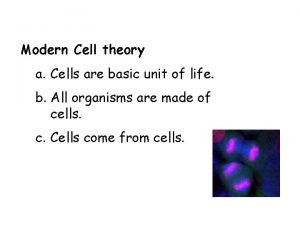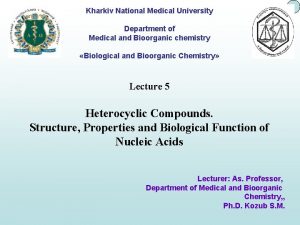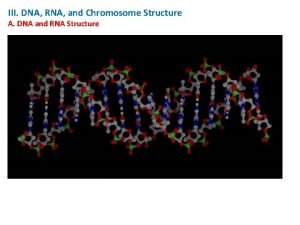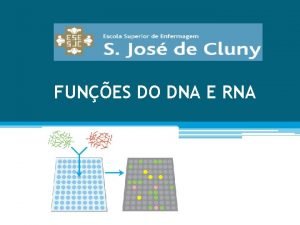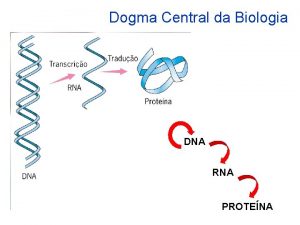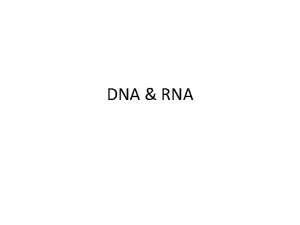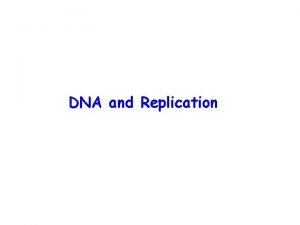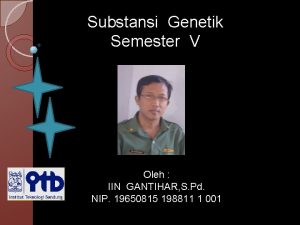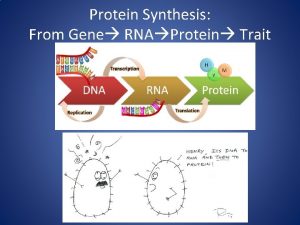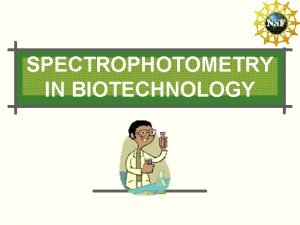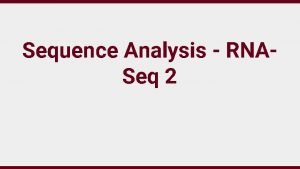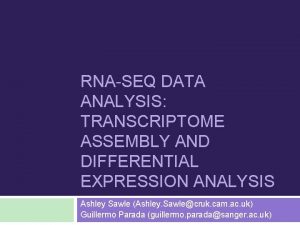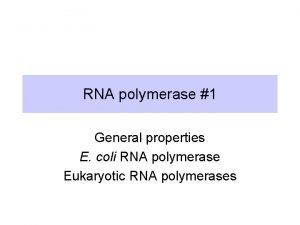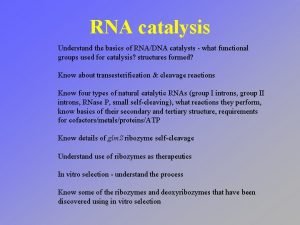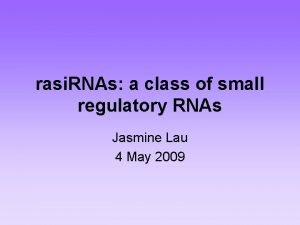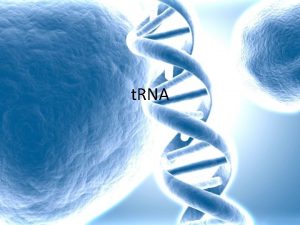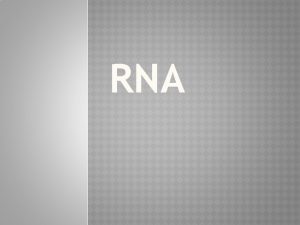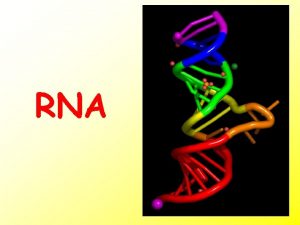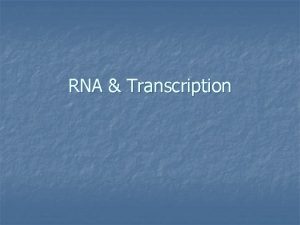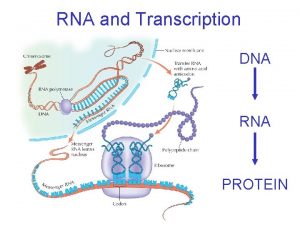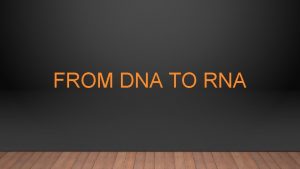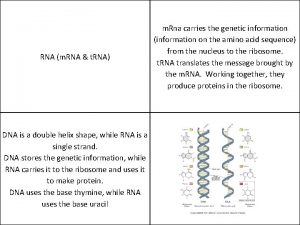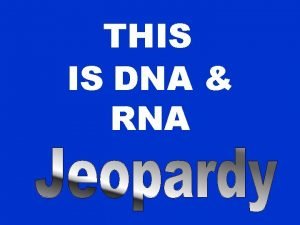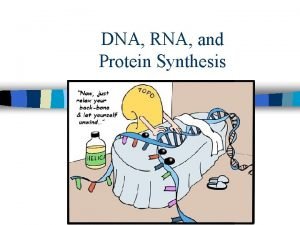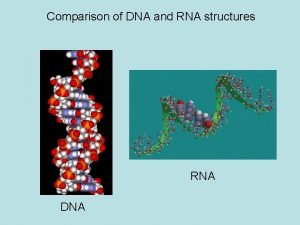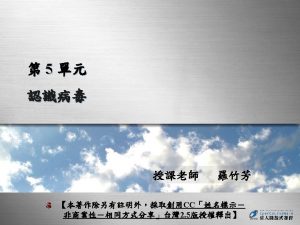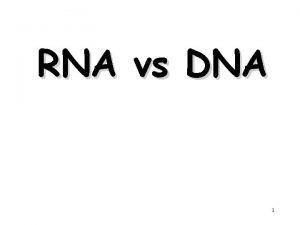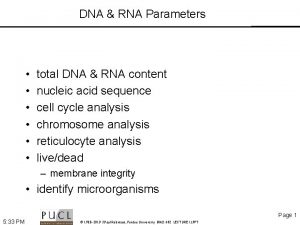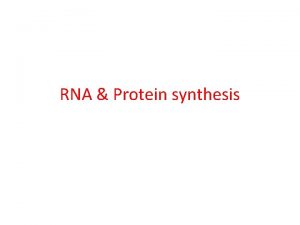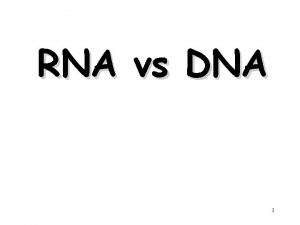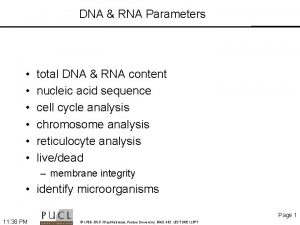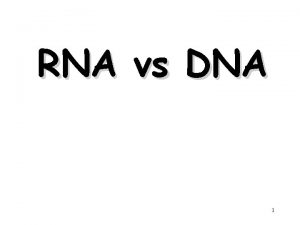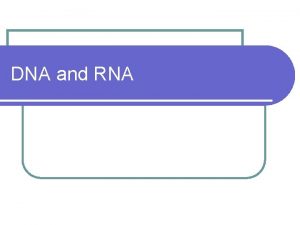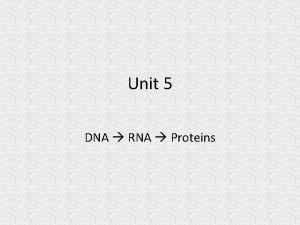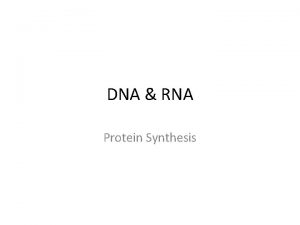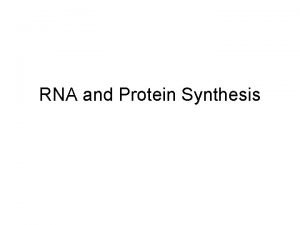Chapter 12 DNA RNA I DNA l A
































































- Slides: 64

Chapter 12 DNA & RNA

I. DNA l A. Griffith & Transformation l Frederick Griffith was trying to figure out how bacteria made people sick-how they cause a certain type of pneumonia. l He isolated 2 strains(types) from mice-both cultured well, but only one caused pneumonia. The culture of the disease causing bacteria were _________colonies while the other was rough. smooth

l 1 -Griffith’s experiments (1928) ¡ Mice injected w/ disease –causing strain got sick and died and nothing happened if injected w/other strain…He wondered if the disease-causing type made a toxin…? ¡ So he took some of disease strain and heated to kill bacteria and then injected into mice…. mice survived suggesting it was not a toxin producing disease

Figure 12– 2 Griffith’s Experiment Section 12 -1 Heat-killed, disease -causing bacteria (smooth colonies) Disease-causing bacteria (smooth colonies) Harmless bacteria Heat-killed, disease(rough colonies) causing bacteria Dies of pneumonia Control (no growth) (smooth colonies) Lives Live, disease-causing bacteria (smooth colonies) Harmless bacteria (rough colonies) Dies of pneumonia

Figure 12– 2 Griffith’s Experiment Section 12 -1 Heat-killed, disease -causing bacteria (smooth colonies) Disease-causing bacteria (smooth colonies) Harmless bacteria Heat-killed, disease(rough colonies) causing bacteria Dies of pneumonia Control (no growth) (smooth colonies) Lives Live, disease-causing bacteria (smooth colonies) Harmless bacteria (rough colonies) Dies of pneumonia

l l 2 -Transformation He mixed his heat –killed w/ live harmless bacteria and injected into mice…. . ____________ Somehow the disease –causing strain passed their disease capacity to harmless bacteria…. . disease – causing strain found in lungs He called this changing of one bacteria by the genes of another ___________. . Thus a factor(gene) from heat killed disease –causing strain was passed on. Mice developed pneumonia transformation

B. Avery & DNA l Team of scientists lead by Avery in 1944 repeated Griffith’s experiment in order to determine which molecule was responsible for the transformation. l They made an extract from the heat-killed bacteria and treated it w/enzymes that kill proteins, lipids and other molecules, inc. RNA

Avery cont’d transformation l __________still occurred so the above molecules were not responsible for transformation l They repeated the experiment but used enzymes that kill______, stopping transformation…. DNA l Therefore ____caused the transformation and thus stores and transmits genetic info

C. The Hershey –Chase Experiment l 1952 -Alfred Hershey and Martha Chase studied viruses-disease-causing particles smaller than a cell. l ___________-virus that infects bacteria. They have a DNA or RNA core and a protein coat…They attach to the surface of a bacterium and inject genetic info into cell. The viral genes act to produce many new bacteriophages and eventually destroy bacterial cell, w/_______bursting out. bacteriophage viruses

l They grew viruses in cultures containing _________________, mixed them w/bacteria and waited a few min. for viruses to inject genetic material. l Then they separated the bacteria from the viruses and tested bacteria for radioactive marker…. . nearly all the radioactivity was P-32 -found in _____---thus concluding it was the genetic material was DNA ! Radioactive markers DNA

Figure 12– 4 Hershey-Chase Experiment Section 12 -1 Bacteriophage with phosphorus-32 in DNA Phage infects bacterium Radioactivity inside bacterium Bacteriophage with sulfur-35 in protein coat Phage infects bacterium No radioactivity inside bacterium

Figure 12– 4 Hershey-Chase Experiment Section 12 -1 Bacteriophage with phosphorus-32 in DNA Phage infects bacterium Radioactivity inside bacterium Bacteriophage with sulfur-35 in protein coat Phage infects bacterium No radioactivity inside bacterium

Figure 12– 4 Hershey-Chase Experiment Section 12 -1 Bacteriophage with phosphorus-32 in DNA Phage infects bacterium Radioactivity inside bacterium Bacteriophage with sulfur-35 in protein coat Phage infects bacterium No radioactivity inside bacterium

D. The Components and Structure of DNA l Scientists questioned how the DNA molecule could do three things 1)carry info from 1 generation to the next 2)putting that info to work and 3)could be easily copied l DNA is a long molecule made of units called ______________________- nucleotides

l The nucleotide is made of 3 basic parts: ___________(sugar), a phosphate group and a_________________ deoxyribose Nitrogenous base

l 2 nitrogenous bases are purines(have 2 rings): ______________(A)and_______ (G) l 2 other nitrogenous bases are pyrimidines (have 1 ring): __________(C)and ______________(T) Adenine , guanine Cytosine and thymine --backbone made by sugar and phosphate w/ bases sticking out sideways

Figure 12– 5 DNA Nucleotides Section 12 -1 Purines Adenine Guanine Pyrimidines Cytosine Thymine Phosphate group Deoxyribose

l 1 -____________Rules-discovered that %’s of Cytosine and guanine were almost equal in DNA and the same was true for adenine and thymine…. Thus A pairs w/T and C w/ G-BASE PAIRING Chargaff’s Rules

Percentage of Bases in Four Organisms Section 12 -1 Source of DNA A T G C Streptococcus 29. 8 31. 6 20. 5 18. 0 Yeast 31. 3 32. 9 18. 7 17. 1 Herring 27. 8 27. 5 22. 2 22. 6 Human 30. 9 29. 4 19. 9 19. 8

l 2 - X-ray evidence-1950’s –Rosalind Franklin used X-ray diffraction to learn about DNA structure ----The scattered X pattern seen begins to show the _____-partial TWISTED STRUCTURE of DNA helix

¡ 3 ---Double helix_ l l Watson and Crick -2 strands wound around each other---like the twisted ladder or spiral staircase Strands held together by H-bonds

Figure 12– 7 Structure of DNA Section 12 -1 Nucleotide Hydrogen bonds Sugar-phosphate backbone Key Adenine (A) Thymine (T) Cytosine (C) Guanine (G)


Interest Grabber Section 12 -2 l A Perfect Copy l When a cell divides, each daughter cell receives a complete set of chromosomes. This means that each new cell has a complete set of the DNA code. Before a cell can divide, the DNA must be copied so that there are two sets ready to be distributed to the new cells.

Section 12 -2 1. On a sheet of paper, draw a curving or zigzagging line that divides the paper into two halves. Vary the bends in the line as you draw it. Without tracing, copy the line on a second sheet of paper. 2. Hold the papers side by side, and compare the lines. Do they look the same? 3. Now, stack the papers, one on top of the other, and hold the papers up to the light. Are the lines the same? 4. How could you use the original paper to draw exact copies of the line without tracing it? 5. Why is it important that the copies of DNA that are given to new daughter cells be exact copies of the original?


II. Chromosomes & DNA Replication l A-DNA & Chromosomes ¡In cytoplasm in prokaryotes ¡In ____________found in cell nucleus in the form of a number of chromosomes(46 humans, 8 Drosophilia and 22 Sequoia trees) eukaryotes

l 1 --DNA length ¡ 1. 6 mm in E. coli(has 4, 639, 221 base pairs)--obviously it must be tightly folded

l 2 -Chromosome Structure ¡ Eukaryotic cells have about 1000 times as many base pairs of DNA than a bacterium ¡ Humans cells have ~ 1 m DNA ¡ Eukaryotic chromosomes contain DNA and a protein , which together make ___________-consisting of DNA tightly packed around proteins called histones chromatin

¡DNA and histone together make beadlike_______________ ¡Nucleosomes pack together to make thick fibers, drawn together during mitosis…also separating l Role of nucleosomes-fold great lengths of DNA into tiny spaces nucleosomes





Prokaryotic Chromosome Structure Section 12 -2 Chromosome E. coli bacterium Bases on the chromosome

Figure 12 -10 Chromosome Structure of Eukaryotes Section 12 -2 Chromosome Nucleosome DNA double helix Coils Supercoils Histones

B. DNA Replication l l l Each strand of DNA double helix has all the info to______________by base pairing Strands are complementary In prokaryotes, this begins @single point and proceeds-often in 2 directions In Eukaryotes, DNA replication begins @ 100’s of places, going both directions until complete _____________is where replication occurs Reconstruct the other half Replication fork

l 1 -Duplicating DNA ¡ _____________or duplication of DNA happens before cell division---ensuring each cell has a complete set of DNA molecules ¡ Each strand of a double helix serves as a ___________or model for new strand ¡ A pairs w/ T and C w/ G template replication

l 2 -How Replication Occurs ¡ Carried out by a series of enzymes that unzip a molecule ¡ __________________ joins individual nucleotides to make a DNA molecule…. also proof reads the new strands DNA polymerase


Figure 12– 11 DNA Replication Section 12 -2 New strand Original strand DNA polymerase Growth Replication fork Nitrogenous bases Replication fork New strand Original strand

III. RNA & Protein Synthesis l The double helix structure explains how DNA is copied, but not how a gene works________are coded DNA instructions that control the production of protein in the cell. l A) The structure of RNA ¡ Long chain of nucleotides ¡ 3 main differences between DNA & RNA: l 1 --Sugar is _________ l 2 ---Generally single-stranded l 3 ---RNA contains ________(U) in place of thymine (T) uracil genes ribose

B. Types of RNA Protein synthesis ¡ Main job=_________-ie the assembly of amino acids into proteins ¡ 3 Types: l __________(m. RNA)-carry copies for instructions from DNA to rest of cell l __________(r. RNA)-type of RNA that helps make up ribosomes, where proteins assembled l ________(t. RNA)transfers each amino acid to the ribosome as it is coded for on m. RNA. messenger ribosomal Transfer

Concept Map Section 12 -3 RNA can be Messenger RNA also called Ribosomal RNA which functions to m. RNA Carry instructions also called which functions to r. RNA Combine with proteins from to to make up DNA Ribosomes Transfer RNA also called t. RNA which functions to Bring amino acids to ribosome

C. Transcription-produces RNA molecules by copying part of nucleotide sequence of DNA into a complementary sequence in RNA ¡ Requires enzyme known as ____________________binds to DNA and separates DNA strands. Then uses one strand as template to make RNA ¡ The enzyme only binds to areas known as promoters-signals that indicate where to make RNA. Similar signals tell where to stop RNA-polymerase

Figure 12– 14 Transcription Section 12 -3 Adenine (DNA and RNA) Cystosine (DNA and RNA) Guanine(DNA and RNA) Thymine (DNA only) Uracil (RNA only) RNA polymerase RNA DNA

D. RNA editing ¡ ____________ in eukaryotic genes , sequences of nucleotides that ARE NOT involved in coding for proteins ¡ ____________-DNA sequence that does code for protein exons introns

E. Genetic Code polypeptide ¡ ___________-chain of amino acids=proteins codon ¡ _________-3 consecutive nucleotides that specify a specific amino acid l Example –UCGCACGGU reads UCG_CAC_GGU and codes for Serine-Histidine-Glycine

The Genetic Code Section 12 -3


l. Universal code l 64 possible 3 base codons l. AUG can specify methionine or start codon l 3 stop codons that do not code for an amino acid

F. Translation ribosome ¡ ___________reads the instructions for the order in which amino acids should be joined by reading m. RNA translation ¡ ______________is the decoding of an m. RNA message into a polypeptide(protein) ¡ Before translation occurs, m. RNA is transcribed from DNA and released into cytoplasm _____________. ¡ Translation begins when m. RNA molecule in cytoplasm attaches to a ___________. ribosome

¡As each codon of the m. RNA moves through the t. RNA ribosome, _______brings in the proper, indicated amino acid and transferred to polypeptide chain ¡Each t. RNA carries one kind of amino acid ¡_________ is a group of 3 bases on a t. RNA that are complementary to a m. RNA codon ¡Ribosome forms a _________bond between amino acids and breaks t. RNA bond releasing it ¡Protein keeps growing until ribosome reaches stop codon on m. RNA peptide anticodon

Figure 12– 18 Translation Section 12 -3

Figure 12– 18 Translation (continued) Section 12 -3

Changes in genetic material Mutations=____________ Gene mutation ¡ l l l A. ---Kinds of Mutations l 1) l ________________-changes in a single gene ___________________-changes in 1 or a few nucleotides-@ a single point in DNA-includes substitutions, insertions and deletions Substitutions usually affect no more than 1 amino acid __________________-insertions or deletions where the reading frame of the codon message is changed-can VERY much alter or even stop the function of a protein Point mutation Frameshift mutation

l l l 2)Chromosomal Mutations-change in the # or structure of chromosomes-can change the location of genes on chromosomes and /or number of copies of some genes. 4 types-1)Deletions-loss of all or part of a chromosome 2)_________-extra copies of a part of a chromosome 3)________reverse directions of parts of chromosomes 4)______-part of one chromosome breaks off and attaches to another translocations duplication inversions

Gene Mutations: Substitution, Insertion, and Deletion Section 12 -4 Substitution Insertion Deletion

Figure 12– 20 Chromosomal Mutations Section 12 -4 Deletion Duplication Inversion Translocation

B. Significance of Mutations l Many have no effect l Harmful effects include genetic disorders and cancer l ____________-contains extra set of chromosomes-bad in most cases but often helpful in PLANTS. polyploidy

V. Gene Regulation l l l operon Only a fraction of a gene expressed at one time __________-group of genes that operate together ________-where repressor binds operon (when it)is turned off Operons not usually found in eukaryotes-these genes are usually controlled individually and regulation more complex---mainly because of cell specialization Hox genes-control differentiation of cells and tissues in the embryo operator

Typical Gene Structure Section 12 -5 Regulatory sites Promoter (RNA polymerase binding site) Start transcription DNA strand Stop transcription

Karyotypes

 Chapter 11 dna and genes
Chapter 11 dna and genes Chapter 12 dna and rna
Chapter 12 dna and rna Chapter 12 section 3 dna rna and protein
Chapter 12 section 3 dna rna and protein Chapter grabber
Chapter grabber Chapter 12 dna the genetic material
Chapter 12 dna the genetic material Unlike dna, rna contains
Unlike dna, rna contains Amoeba sisters mutations worksheet
Amoeba sisters mutations worksheet Venn diagram rna and dna
Venn diagram rna and dna What is the goal of replication
What is the goal of replication Dna to rna rules
Dna to rna rules Transcription translation venn diagram
Transcription translation venn diagram Dna double helix coloring worksheet answer key
Dna double helix coloring worksheet answer key What is code 1
What is code 1 Que es
Que es Nucleotide diagram
Nucleotide diagram Dna and rna
Dna and rna Dna to rna transcription
Dna to rna transcription Rna or dna
Rna or dna Big q
Big q Nucleic acid
Nucleic acid Dna and rna
Dna and rna Dna rna protein central dogma
Dna rna protein central dogma Dna rna and proteins study guide answers
Dna rna and proteins study guide answers Fraction
Fraction Lenine
Lenine Rna transfer
Rna transfer Virusmax
Virusmax Dna rna and protein synthesis study guide
Dna rna and protein synthesis study guide Rna dna
Rna dna Dna and rna
Dna and rna Ribosom
Ribosom What does dna have that rna doesnt
What does dna have that rna doesnt Microarray analysis
Microarray analysis Dna rna protein
Dna rna protein Dna rna protein diagram
Dna rna protein diagram Corona virus dna or rna
Corona virus dna or rna Dna rna
Dna rna Aug amino acid
Aug amino acid Venn diagram of dna and rna
Venn diagram of dna and rna Dna to rna transcription
Dna to rna transcription Nucleic acid made up of
Nucleic acid made up of Nucleic acids
Nucleic acids What is the process called
What is the process called Why dna is more stable than rna?
Why dna is more stable than rna? James dewey watson
James dewey watson Structure of a chromosome
Structure of a chromosome Proteinas histonas
Proteinas histonas Dogma central da biologia molecular mapa mental
Dogma central da biologia molecular mapa mental Fred griffith dna
Fred griffith dna Minor groove
Minor groove Substansi genetik dna dan rna mempunyai kesamaan yaitu
Substansi genetik dna dan rna mempunyai kesamaan yaitu Protein
Protein Replication
Replication Bioflix activity dna replication lagging strand synthesis
Bioflix activity dna replication lagging strand synthesis Coding dna and non coding dna
Coding dna and non coding dna Enzyme involved in dna replication
Enzyme involved in dna replication Totipotent cell
Totipotent cell Biotechnology topics
Biotechnology topics Messenger rna sequence
Messenger rna sequence Sam file
Sam file Rna polymerase 1 2 3
Rna polymerase 1 2 3 Rna as catalyst
Rna as catalyst Section 12 3 rna and protein synthesis
Section 12 3 rna and protein synthesis Messenger rna codons
Messenger rna codons Rasi rna
Rasi rna

